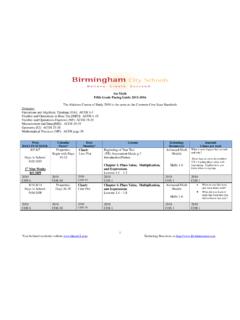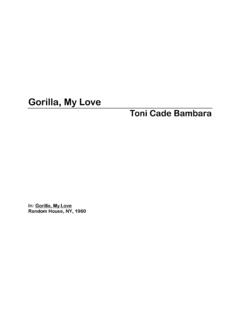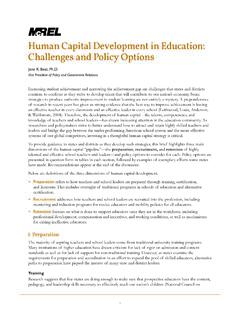Transcription of Opinion/Argument Writing Packet Grades 3-6
1 2013 Page 1 Backwards Planning for Success with Writing with the new California Common Core Standards Opinion/Argument Writing Packet Grades 3-6 2013 Charlotte Knox, Page 2 Opinion/Argument Writing Table of Contents 3-6 Page The New California Common Core Standards (CCCS) Overview 3 Anchor Standards: College and Career Readiness: Text Types and Purposes 4 Anchor Standards: College and Career Readiness: Production and Distribution of Writing 5 Anchor Standards: College and Career Readiness: Research to Build Knowledge 6 What is an Argument?
2 7 Progression of Opinion to Argument Writing 8 Persuasion vs. Argument 9 Opinion/Argument and College and Career Readiness Michelle Karns 10 Opinion/Argument Writing in the new Common Core Standards Standards for K-8 11-12 CCCS Anchor Paper Grade 4 13-14 CCCS Anchor Paper Grade 6 15-16 CCCS Writing Rubric for Grade 5-SAMPLE 17 Write a Sample Anchor Paper with Your Class 18 Gradual Release of Responsibility Model of Instruction 19 Teaching Writing Scaffolding 20-21 The Writing Process Model 22 Building Talk Time into the Writing Process 23-24 Jumpstart 25 Talk Tickets 26-27 Six Week Backwards Planning for Success with Writing - Example Planning Sequence of Opinion/Argument Writing Lessons 28 Week 1: Focus on Modeling and Mentor Texts 29 Week 2-3.
3 Shared and Guided Writing Plus Guided Writing and Mini-Lessons as Needed 30 Week 4-5: Focus on Revision and Editing 31 Week 6: Focus on Sharing and Response Plus On-Demand Dress Rehearsal 32 Opinion/Argument Writing Tool Kit 33 Picture Examples of Opinion/Argument Writing 34 Week 1 Opinion/Argument Lesson Sequence for Older Students 35 Week 1 Warming Up to Writing Opinion/Argument Writing with Older Students 36-38 Week 1 Identifying Elements of Opinion/Argument Writing using Color Coding 39-40 Week 1 Teacher Modeling with Color Coding 41 Week 2 Shared Writing of Opinion/Argument Essay 42 Week 2 Writing An Argument/Opinion Essay With Your Students 43 How to Write an Opinion/Argument Letter 44 Opinion/Argument Language Frames 45 Opinion/Argument Essay Planning Guide 46 Paragraph Frames for Opinion/Argument Writing 47 Week 1
4 Writing Reviews as Opinion Writing 48 Review Writing : Basic Structures by Category and Review Writing Planning Form 49-50 Opinion Writing Organizer 51 Week 2-3 Building a How-To Chart with Your Students 52-53 Week 3-4 Guided Writing 54-56 Opinion/Argument Rap 57-58 Explorer s Argument Advertisement and Essay 59-62 Cues, Sequences, and Transition Words 63-64 Ideas for Opinion/Argument Writing : Sample Prompts that Appeal to Students 65 Opinion/Argument Reading and Writing Vocabulary 66-67 Writing Checklist: Opinion/Argument Writing 3-6 68 Writing Conference Strategies; One-on-One Conferences; and Conferencing 69-72 Learning About Revision and Editing 73 Implementing a Publishing Week in the Primary Classroom 74-76 The Authors Chair 77 Editing is Fun Poster 78 The Editing Machine 79 Resources for Teaching Opinion/Argument Writing 80 Included are Sections from Backwards Planning for Success with Writing Handbook 2011 Charlotte Knox 2013 Page 3 The New California Common Core Standards (CCCS)
5 College and Career Readiness Anchor Standards Strands Grade Specific K-12 This version adapted from Key ideas and details Craft and structure Integration of knowledge and ideas Range of reading and level of text complexity FOUNDATIONAL SKILLS Print concepts Phonological awareness Phonics and word recognition Fluency Writing Text types and purpose Production and distribution of Writing Research to build and present knowledge Range of Writing LITERACY in HISTORY/SOCIAL STUDIES, SCIENCE and TECHNICAL SUBJECTS Reading and Writing Standards for Content Area Subjects SPEAKING and LISTENING Comprehension and collaboration Presentation of knowledge and ideas APPENDICES A. Research behind the standards and glossary of terms B.
6 Text exemplars illustrating complexity, quality, and range of reading appropriate and sample performance tasks for various Grades C. Annotated samples of students Writing at various Grades LANGUAGE Grade specific standards Conventions of standard language Knowledge of language Vocabulary acquisition and use 2013 Page 4 College and Career Readiness: Standards for Writing Text Types and Purposes Text Type Anchor Standards In My Classroom Opinion/ Argument 1. Write arguments to support claims in an analysis of substantive topics or texts using valid reasoning and relevant and sufficient evidence. Informative/ Explanatory 2. Write informative/explanatory texts to examine and convey complex ideas and information clearly and accurately through the effective selection, organization, and analysis of content.
7 Narratives 3. Write narratives to develop real or imagined experiences or events using effective technique, well-chosen details, and well-structured event sequences. 2013 Charlotte Knox, Page 5 College and Career Readiness: Standards for Writing Production and Distribution of Writing Anchor Standards In My Classroom 4. Produce clear and coherent Writing in which the development, organization, and style are appropriate to task, purpose, and audience. 5. Develop and strengthen Writing as needed by planning, revising, editing, rewriting, or trying a new approach. 6. Use technology, including the Internet, to produce and publish Writing and to interact and collaborate with others.
8 2013 Charlotte Knox, Page 6 College and Career Readiness: Standards for Writing Research to Build Knowledge Anchor Standards In My Classroom 7. Conduct short as well as more sustained research projects based on focused questions, demonstrating understanding of the subject under investigation. 8. Gather relevant information from multiple print and digital sources, assess the credibility and accuracy of each source, and integrate the information while avoiding plagiarism. 9. Draw evidence from literary or informational texts to support analysis, reflection, and research. Range of Writing 10. Write routinely over extended time frames (time for research, reflection, and revision) and shorter time frames (a single sitting or a day or two) for a range of tasks, purposes, and audiences.
9 2013 Charlotte Knox, Page 7 What is an Argument? An argument is a claim supported by evidence. Arguments are used for many purposes to change the reader s point of view, to bring about some action of the reader s part, or to ask the reader to accept the writer s explanation or evaluation of a concept, issue or problem. An argument is a reasoned, logical way of demonstrating that the writer s position, belief, or conclusion is valid. In English/Language Arts, students make claims about the worth or meaning of a literary work or works. They defend their interpretations or judgments with evidence from the text(s) they are reading about. What is an argument?
10 ?? 2013 Charlotte Knox, Page 8 Opinion/Argument Standards K-12 Progression Progression of Opinion to Argument Writing Kindergarten Compose opinion pieces State an opinion or preference Grades 1-2 Write opinion pieces Introduce topic, opinion, reason, closure Grades 3-5 Write opinion pieces on topics Support point of view with reasons and information Grades 6-8 Write arguments to support claims Clear reasons and relevant evidence Grades 9-12 Write arguments to support claims in an analysis of substantive topics or texts Valid reasoning, relevant and sufficient evidence 2013 Charlotte Knox, Page 9 Persuasion vs.











